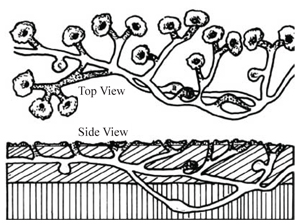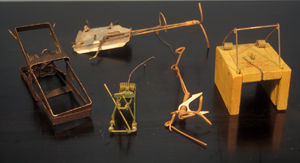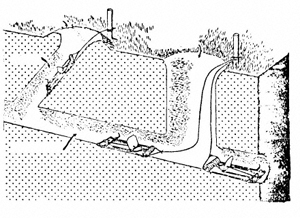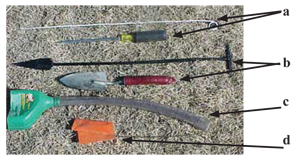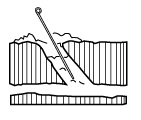G1509
Controlling Pocket Gophers in Nebraska
This NebGuide describes pocket gophers and the damage they can cause. Several methods of control are discussed.
Stephen M. Vantassel, Extension Wildlife Damage Coordinator
Scott E. Hygnstrom, Extension Specialist — Wildlife Damage Management
Dennis M. Ferraro, Extension Educator
Bruce E. Anderson, Extension Forage Specialist
|
Pocket gophers are burrowing rodents with stocky bodies, small ears and eyes, and a sparsely-haired tail (Figure 1). Pocket gophers derive their name from the large, external fur-lined cheek pouches that allow them to carry food or bedding material to underground caches or nests. They are well-adapted to living belowground. Pocket gophers can gnaw on roots without ingesting soil because their lips can close behind their large incisors. Powerful front shoulders and long claws allow them to excavate and transport nearly 50 wheelbarrows of soil per acre per year (12 cu/ft/acre/year). Typically, pocket gophers appear aboveground only to excavate soil to the surface or to disperse it to new areas.
Four species of pocket gophers live in Nebraska. The northern pocket gopher (Thomomys talpoides) resides in the short-grass prairie of the northwestern and southwestern portions of the Panhandle. It is the smallest of the four species, weighing 2-5.5 ounces. The plains pocket gopher recently was divided into three species. Geomys jugossicularis halli lives in southwestern Nebraska. Geomys lutescens is primarily found in Nebraska’s Sandhills. Geomys bursarius halli is found in eastern Nebraska. It is the largest species of pocket gopher and can weigh up to 14 ounces. Pocket gophers can be found in alfalfa fields, pastures, rangelands, roadside areas, and backyards. The color of their short fur matches that of the surrounding soil, ranging from a sandy-brown in western Nebraska to a dark chocolate brown in the east. Pocket gophers are not protected by law in Nebraska.
Life History
Although pocket gophers reside in proximity to each other, they live alone except when mating or raising young. Mating occurs in late winter to spring. Females give birth to a single litter of three to four young between March and May. Males do not assist in rearing the young. In late summer, the young disperse to find or build their own tunnel systems.
Pocket gophers usually forage belowground, feeding on roots and occasionally pulling plants down into their burrows to feed on stems and leaves. They prefer succulent forbs (prickly pear, dandelion) and legumes (alfalfa) but will eat many kinds of plants, including the roots of trees, grasses, perennial bulbs, and garden vegetables.
Pocket gophers create extensive burrow systems (Figure 2). Their feeding tunnels are typically 4-18 inches deep, while their nest chambers may be located 2-6 feet below the soil’s surface. They maintain their tunnel systems throughout the year. During winter, gophers slow their activity and periodically travel through existing tunnels to feed on caches of roots, stems, and leaves. Pocket gophers build most of their mounds in early spring and fall or in periods of wetter and cooler soil conditions. Each pocket gopher can create dozens of mounds, sometimes within the span of a few days. Landowners must understand that despite the number of mounds, pocket gopher densities rarely exceed eight animals per acre. A pocket gopher’s burrow system may cover more than 1 acre, although the active portion will typically extend about 100 feet in diameter. Pocket gophers deposit the excavated soil on the ground’s surface through lateral burrows that run at a 45° angle to the soil’s surface. These soil deposits typically are fan- or bean-shaped and extend 8-12 inches across. In contrast, mole mounds are typically conical in shape and 4-6 inches in diameter. For additional tips on distinguishing between the activity of moles and pocket gophers, consult NebGuide G1538 Moles and Their Control.
Immediately after constructing a mound, the gopher plugs the burrow with soil to a depth of 6-12 inches. Occasionally, a lateral burrow is plugged without soil excavation or creation of a mound. Below and offset to the lateral burrows lay the feeding burrows in which pocket gophers eat roots and pull down plants. Pocket gophers also dig through snow, leaving deposits of excavated soil in the tunnels, called soil castes, which then remain aboveground after the snow melts.
Economic Importance
Pocket gopher activity can significantly impact humans. They adversely affect turf and crops by directly feeding on roots, stems, and leaves; by exposing plant roots to drying; and by burying plants with excavated soil. In Nebraska, plains pocket gophers have reduced forage yields on rangelands by 21-49 percent and on hay meadows by as much as 30 percent. In alfalfa fields, pocket gopher damage has reduced production up to 17 percent in irrigated alfalfa and by as much as 35 percent in dryland alfalfa.
Pocket gophers girdle the stems of young trees, chew or sever tree roots as large as 6 inches in diameter, and can damage trees up to 10 years old. Gophers are particularly troublesome when they exploit the tunnels created by tree-planting machines in windbreaks and eat the roots of young trees. Occasionally, pocket gophers burrow through snow and damage young tree trunks. Signs of gophers include a smooth, gnawed surface with 1/8-inch-wide tooth marks or deeply gnawed wood on stems that has a sculptured effect.
Their digging also can affect the integrity of airport runways, roadbeds, dams, dikes, canals, and other earthen structures. Their mounds can dull and plug hay-harvesting equipment and can leave fields very rough. Pocket gophers can severely damage buried utility cables, communication lines, and irrigation pipes.
Ecological Role
Pocket gopher burrowing promotes soil health through the vertical cycling and mixing of soil nutrients and organic matter. Their efforts also promote diversity among prairie plants. Research has shown that their digging reduces water runoff and erosion. Pocket gophers also provide food for predators, such as skunks, foxes, bobcats, weasels, hawks, owls, and gopher snakes (“bull snakes”).
Controlling Damage
Landowners can use several methods to reduce pocket gopher damage to their property. Management is most effective when landowners incorporate a combination of cultural and population management methods using the principles of integrated pest management. As with all wildlife damage management, proper timing and vigilant monitoring are essential to long-term success.
Cultural Methods. Elimination or significant reduction of preferred food sources can reduce the number of pocket gophers that survive in an area and decrease damage caused by them. In grasslands, eliminate weeds and other broad-leaved plants by hand digging or applying herbicides. Protect alfalfa fields from invasion by pocket gophers by planting annual row crops in adjacent fields. Small grain crops also can serve as buffers around alfalfa or tree plantations.
Adjust crop rotations so that row crops are planted for two successive years before being converted to alfalfa. Choose alfalfa varieties with fibrous roots rather than a single taproot, or those with crowns that are broad and positioned close to the soil surface, instead of varieties with crowns that are small and partially elevated.
Flood irrigation can effectively control pocket gophers in fields where this cultural method is available because gophers avoid tunnel systems where flooding occurs.
|
Exclusion. Cables, lines, and pipes buried 4 to 12 inches below the surface are particularly vulnerable to damage from gnawing. Protect underground lines by surrounding them with 6 inches of gravel that is 1-2 inches in diameter. Cable companies use steel armor or place wire basket protectors around cables to protect them from gophers. Use pipe or cable that is greater than 2.1 inches in diameter for underground water lines or conduit because pocket gophers have difficulty gnawing materials larger than this. Gopher damage also can be reduced by wrapping cables with 0.01-inch thick copper tape or metal sheathing.
Population Reduction. The fastest way to reduce damage by pocket gophers is to decrease their populations through direct control. Research suggests that in forest plantations reducing populations to two pocket gophers per acre achieves sufficient economic results. Since comparable information for other crops or rangelands is not available, landowners should control pocket gophers in a 100-foot buffer surrounding the treated field.
Traps. Due to the labor involved, trapping is best employed in fields smaller than 20 acres, in larger fields that are sparsely or sporadically inhabited by pocket gophers, or as a follow-up to toxic bait applications. Trapping can substitute for chemical control in areas that are near surface water or where the water table is high. Labor costs for trapping are about 35 percent higher than use of toxic baits.
Many styles of traps are available (Figure 3) and trap sizes vary among models and brands. Select traps that relate to the average size of pocket gophers in the local population as some pocket gopher traps come in two sizes.
Pocket gophers can be trapped in the main or lateral tunnels. To find the tunnels, consult the steps for applying toxicants by hand in this NebGuide. When setting main tunnels, set two traps on the main burrow’s floor, pointing in opposite directions (Figure 4). For lateral tunnels, place a single trap on the lateral burrow’s floor.
Some trappers prefer to close the hole after setting traps, while others leave the hole open. Those who favor closing the hole argue that closed holes reduce misfires because the gopher is less likely to push soil into the trap. Those who favor leaving the hole open contend that the light and air movement encourages gophers to visit the opening. UNL research has shown that gophers plug openings whether the trapper closes the hole or not. At present, UNL scientists believe the decision to close or leave the hole open is matter of personal choice and need for safety. Since the hole created for the main tunnel can be quite large and deep, UNL recommends that the hole be properly marked and the site secured to prevent people or nontarget animals from injury. If you decide to close the hole, use a ¼-inch plywood board for the main tunnels. Lateral tunnels only need something like a shingle or plastic lid. In both cases, make sure that light cannot enter the opening.
Trappers should be prepared for many misfires. Gophers frequently bury traps with soil or plug holes without firing the traps. Ensure that all equipment is in good working order. Clean rusted traps before covering lightly with a quality rust-resistant paint, as rusted traps are prone to misfires. Secure all traps to a survey flag using a metal wire to prevent loss. Check traps carefully as live gophers can inflict painful bites.
Toxic Baits. As of April 2008, toxic baits registered for control of pocket gophers in Nebraska include:
- 0.5 percent strychnine-treated grain baits
- 2 percent zinc phosphide-treated pellets and grain baits
- 0.005 percent chlorophacinone pellets and grain baits
- 0.005 percent diphacinone bait bars
Some toxicant formulations are Restricted Use Pesticides (RUPs). Strychnine-treated bait and zinc phosphide-treated bait, when packaged in quantities greater than 5 pounds, are RUPs. Individuals in Nebraska that purchase or apply the baits as private or commercial applicators must be certified and licensed by the Nebraska Department of Agriculture. Both strychnine and zinc phosphide are single-dose rodenticides. Zinc phosphide and strychnine should be rotated with other baits in a long-term baiting program so that pocket gophers do not develop a taste aversion to them.
|
Chlorphacinone and diphacinone are anticoagulant rodenticides. Gophers must eat repeated applications to have a lethal effect. Both chlorphacinone and diphacinone are General Use Pesticides (GUPs) when labeled for pocket gopher control. Similar formulations labeled for the control of prairie dogs are RUPs. Be certain to purchase bait labeled for the pest you intend to control, as the directions for use differ. Check for current registrations with the Nebraska Department of Agriculture (www.kellysolutions.com/ne) before purchasing and follow all pesticide label instructions when applying toxic baits.
Toxic baits can be applied to pocket gopher burrows in three ways: 1) hand baiting through opened mounds, 2) hand baiting through holes opened above burrows, and 3) machine baiting. Applying bait aboveground is both ineffective and illegal. Any bait found aboveground should be removed and disposed of according to label instructions.
Hand Baiting. Several tools are useful for hand baiting (Figure 5). To place bait into a pocket gopher burrow, dig through the mound and soil plug or use a probe to directly enter the burrow from above. To dig, choose a freshly excavated mound that is small and bean- or fan-shaped. The most recently excavated mounds generally are at the perimeter of the burrow system. Use a 2-foot length of 9-gauge wire or a long screwdriver to probe through the mound on the concave side or at the apex of the fan to locate the soil plug and the open burrow below (Figure 6). Use a hand trowel or small shovel to excavate through the plug. Place a quantity of bait specified by the label (usually a teaspoon) deep into the burrow using a long-handled spoon. Bait bars also can be applied using this technique. To probe and enter a burrow from above, use a pointed 3/8-inch diameter metal rod to probe 12-18 inches from the mound’s concave side. The burrow will typically lie 8-18 inches below the surface. The probe will accelerate as you enter the burrow. Apply bait through the opening made by the probe.
Several commercial probes have bait holders to dispense the bait through the hollow probe. You may have to use a 3/8-inch metal rod as a probe prior to probing with the larger diameter models to enter soils that are dry, compacted, or of high clay content. Whether hand baiting through the mound or by probes, always close the opening by kicking it with the heel of your shoe. Be careful to prevent loose soil from covering the baits in the burrow.
For best results when hand baiting, apply baits to all freshly excavated mounds. A pocket gopher may excavate several mounds at different areas of its tunnel system. Apply bait at two to five locations within a single tunnel system so the animal can easily find the bait. Baits that remain in the tunnel may be consumed by gophers that subsequently enter the system.
Machine Baiting. Machine baiting can be done by using a tractor-drawn burrow-building machine or Gopher Getter® to create tunnels in which bait is applied. Gophers enter the tunnels created by the machine during their normal digging activities and find the bait. Several models of burrow builders are available. For detailed information, see the NebGuide Using Burrow Builders for Pocket Gopher Control (G1510). Watch product labels, as some manufacturers have separate labels for hand application and burrow builder applications.
Frequency and Time of Baiting. Regardless of the application method, the efficacy of toxic baits can range from 10 to 90 percent. A few simple strategies will improve success:
- Apply rodenticides in early March or April, when pocket gophers are most active and their populations are at their lowest.
- Avoid using grain baits when the soil is wet to prevent bait spoilage.
- Apply baits in tunnels below new mounds.
- Be prepared to apply baits a second time. It is extremely rare to achieve control of 70 percent or greater with only one baiting. In hand or probe-applied baiting, apply toxic baits a second time if new mounds appear within three to seven days.
Burrow builders are typically used in alfalfa before spring growth and after the last harvest. New mounds may appear for 10-14 days after burrow builders are used because it usually takes time for the pocket gophers to find the baits in the machine-made tunnels.
Fumigants. Fumigants are not effective because pocket gophers seal off the tunnel when they encounter the gas. Furthermore, fumigants are unlikely to spread through the extensive burrow system, particularly if they are not similar in weight to the air that exists within the burrows.
Two fumigants registered for controlling pocket gophers include tablets or pellets of 55 percent to 60 percent aluminum phosphide and gas cartridges with various active ingredients. Products that contain aluminum phosphide are RUPs. Gas cartridges are GUPs and are commonly sold at local lawn, garden, or farm supply stores. Aluminum phosphide slowly releases toxic phosphine gas over a period of hours, while gas cartridges are ignited and burn quickly, eliminating the oxygen within the burrow and emitting toxic carbon dioxide and carbon monoxide gas.
Fumigants are applied into the burrow using the procedure for hand baiting. Low soil moisture can reduce the effect of aluminum phosphide or gas cartridges. For more information on fumigants, see the NebGuide Fumigation of Burrowing Rodents with Aluminum Phosphide or Gas Cartridges (G1477). Propane exploders are not legal to control any wildlife in Nebraska. They can cause injury to users and bystanders, as well as ignite fires.
Evaluating Your Results. Evaluation of your trapping or baiting efforts can be done in several ways, depending upon your situation. In backyards, monitor the treatment area for 7-10 days, looking for the appearance of new mounds. Farm and ranch managers, orchardists, and others can do a more thorough evaluation by flagging at least 25 mounds in separate burrow systems within the treatment area. Open each burrow with a hand trowel and revisit the opened holes about 24-48 hours later to see if they have been plugged. If so, a pocket gopher is still in the tunnel system. When using anti-coagulant baits, wait at least two weeks to open holes and evaluate your success. If machine baiting with burrow builders, wait at least one week to open holes.
Leveling Mounds. After treatment, use hand or tractor-drawn implements to scrape or rake the mounds to spread the soil over the surface. Examine the field for mounds that reappear, indicting a lack of effectiveness in a tunnel system.
Land Maintenance. Whether you use traps, toxic baits, or cultural methods, pocket gopher numbers can recover within a year if control is not maintained.
Community Effort. Reduce the potential of pocket gophers moving in from adjacent fields by encouraging neighbors to control gophers on their land. Enlist the help of neighbors to develop a community-wide control program to limit gopher populations in source areas. Consider mowing, cultivating, or burning the source areas at the end of the growing season to allow for better detection of mounds and subsequent control.
Border Patrols. Closely monitor the edges of your property as reinvasion, signified by new mounds, usually begins along the field edge. Mounds also appear near hay bales, loaves, or stacks where gophers seek warmth and food below the soil. Patrol 100 feet outside of the field perimeter at least three times during the growing season. To maintain a 100-acre field, you will likely spend as little as one hour (hand baiting) to six hours (trapping) three times each growing season.
Methods That Don’t Work. Mothballs and other home remedies frequently fail to work because the animals will likely close and reroute their burrow if the odor or taste is obnoxious to them. Plants, such as chrysanthemum, castor bean (Ricinus), and “gopher” spurge (Euphorbia), have not been proven effective in repelling pocket gophers. Capsaicin has been used to reduce gnawing on buried cable, but no such products currently are registered for use against pocket gophers. Electronic, magnetic, and vibrating devices have not been proven effective.
Predators, such as hawks, owls, and snakes, will not remove enough pocket gophers for effective control. Gophers rarely leave the safety of their belowground tunnels to venture on the surface. They plug any breaches in their tunnel system as soon as they are discovered. Pocket gophers also readily block attempts by predators to dig into their tunnels by fending them off with their strong teeth and claws, by retreating into their extensive burrow system, or by pushing soil between them and predators.
Acknowledgments
This NebGuide is a revision of an earlier one created by Dallas R. Virchow, Project Coordinator — Distance Education, Wildlife Damage Management; Scott E. Hygnstrom, Wildlife Damage Extension Specialist; and Bruce E. Anderson, Extension Forage Specialist.
This publication has been peer reviewed.
Disclaimer Reference to commercial products or trade names is made with the understanding that no discrimination is intended of those not mentioned and no endorsement by University of Nebraska–Lincoln Extension is implied for those mentioned. |
Visit the University of Nebraska–Lincoln Extension Publications Web site for more publications.
Index: Wildlife Management
Wildlife Damage Control
2003, Revised January 2009

